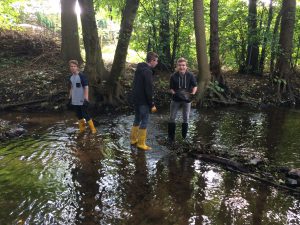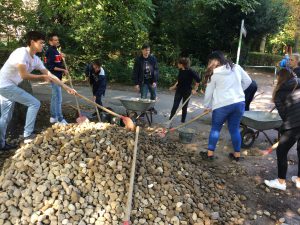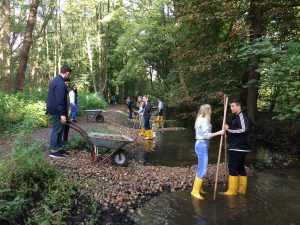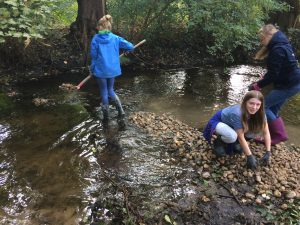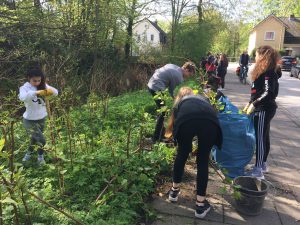GLOBE
Hinweis: Dies ist eine automatische Übersetzung des Seiteninhalts (English). Für verbindliche Informationen gilt der deutsche Originaltext. Original anzeigen
Note: This is an automatic translation of the page content (English). For authoritative information, the German original text applies. Show original
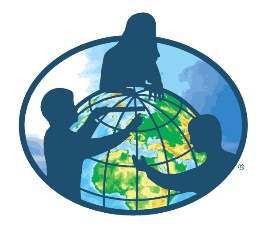 GLOBE has been offered at Gymnasium Rahlstedt in the elective area for grades 8 and 9 since 1997. With GLOBE we offer a subject that almost exclusively focuses on environmental engagement, enabling students to actively engage on the school grounds and in the neighborhood for many years and, beyond that, to connect with the world.
GLOBE has been offered at Gymnasium Rahlstedt in the elective area for grades 8 and 9 since 1997. With GLOBE we offer a subject that almost exclusively focuses on environmental engagement, enabling students to actively engage on the school grounds and in the neighborhood for many years and, beyond that, to connect with the world.
The GLOBE program (Global Learning and Observations to Benefit the Environment) is a worldwide project that links research and education in the field of environment and natural sciences. Students, teachers, and scientists work together to achieve a deeper understanding of the Earth system and the interplay of environmental components such as climate, water, soil, and their effects on flora and fauna through long-term observation.
The domain Environmental Education aims to develop a sense of responsibility and active commitment to the environment among students. It is part of education for sustainable development, which creates overlaps with the areas Traffic Education, Intercultural Education and especially Global Learning.
As a climate school we strive to implement our climate protection plan and set new goals. This characterizes GLOBE instruction as well as work on long-term projects, such as the renaturation of Wandse or the collaboration with cooperation partners such as the One World AG or the Environmental AG.
Further information:
- Contents of GLOBE instruction
- What is the GLOBE program?
- Our river Bach sponsorship
- Photos from GLOBE classes (2017 and 2018)
- Completed actions and projects
- Environmental AG
- One World AG
What is the GLOBE program?
GLOBE (Global Learning and Observations to Benefit the Environment) is a worldwide program that links research and education in the field of environment and natural science. Students, teachers, and scientists work together to achieve a deeper understanding of the interaction of the individual environmental components climate, water, soil and biology, and thus of the “Earth system.”
One goal is to strengthen the environmental awareness of students, especially regarding global contexts, through their own contribution to environmental observation and research. At the same time, they are introduced to working with measurement methods and devices, objective observation, and working with time series. Schools around the world form a dense network of measurements to regularly collect environmental data. These data are entered into a central database via the Internet, where they are collected and visualized. All measurements are publicly accessible online. Scientists also use the data. The expectation is that these data will provide valuable insights into the causes of global and local environmental changes. More than 12,000 schools in about 100 countries are involved now, more than 400 schools in Germany. Teachers develop the necessary background knowledge with their students and try to derive connections from their own data as well as from data from other countries. Students are guided in an engaging way to scientific thinking and working. They can rely on scientists to clarify questions.
For example, we report the data from our weather station to the GLOBE program and have also planted special plants to compare when they bloom somewhere in the world.
Detailed information can be found on the program’s website: https://www.globe.gov/about/overview
Our Bach sponsorship
The care and redesign of the Wandse in our district has long been a fixed part of the GLOBE instruction at Gymnasium Rahlstedt. We now oversee the section from the Rahlstedt shopping center (Mecklenburger Straße) to the Altrahlstedt church (Altrahlstedter Stieg). Students have planted more than 500 trees and shrubs along the shoreline and moved more than 100 tons of rocks and gravel to improve the river structure. In addition, numerous invasive species were removed each year. A focus in recent years was our collaboration in the Forelle 2010 project, in which students from Gymnasium Rahlstedt helped create the conditions for the reintroduction of rainbow trout in our Bach segment. The positive effects of our actions, such as stronger meandering, increased flow speed, and fewer sand deposits in the riverbed, can be observed. The water quality has also improved by more than one class of quality.
The following map shows the course of our Bach segment and its proximity to the school. The section is about 1.2 km long. In addition to the aforementioned activities, we have also uncovered a number of illegal discharges and helped eliminate them. For our commitment we have already received several awards. 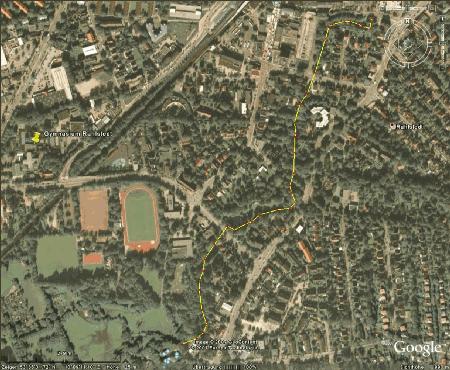
Our actions to renature the waterways are carried out in cooperation with the District Office Wandsbek – Water Management Department –.
https://www.hamburg.de/wandsbek/bachpatenschaften/
Anyone who would like to join in an action around our Bach sponsorship is welcome to contact via the school office with the responsible teacher, Mrs. Gebauer. We welcome support!
Completed actions and projects:
Since 2018 there has been functional waste separation in our new school building and, in addition, a large deposit return station in the atrium. For grades 9–12 there was previously an event under the name RedUse. It focused on reducing waste, recycling, and alternative uses of "garbage".
We hold a Climate Breakfast every year. But what do breakfast and protecting the climate have to do with each other? The climate scouts at our school will soon be able to explain this, and the school community will be informed with posters and notices. Our goal is a school-wide climate breakfast.
Our Upcycling Markets were a success. We were able to raise a lot of money for our partner school in South Africa. This year as well we would like to produce and sell products again.
We now have a school collection with our logo. As a long-standing climate school it is important to us to ensure sustainable and fair production for our items. We regularly expand our school collection and look for even better alternatives. The products are sold at major events in the school.
Once a school year you can also order T-shirts and sweatshirts with the GyRa logo.
Several actions of the Climate Art School, such as “Art by the River,” were completed in collaboration with the Art Department.


